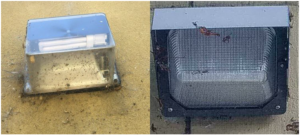It’s widely accepted that LED lighting is one of the “low hanging fruit” of energy efficiency1. Upgrading conventional lighting, such as incandescent, halogen and florescent, in buildings to LED is a simple and effective way to substantially reduce electricity consumption and have impactful non-energy related advantages. For example, the technology emulates natural daylight which can improve visibility and property aesthetics in addition to mental health and cognitive benefits for occupants2. PG&E’s Energy Savings Assistance Common Area Measures (ESA CAM) program works with property owners and contractors to maximize all potential benefits for residents and property owners when planning energy efficiency upgrades.
During every ESA CAM audit program staff record the existing conditions of all lighting lamps and fixtures to inform energy upgrade recommendations. ESA CAM typically recommends lamp (i.e., bulb) replacements – or a LED retrofit kit – when fixtures are compatible with available LED products and are still in good working condition. When fixtures are visibly broken and found or reported to be inoperable during the audit ESA CAM staff will recommend full fixture replacement to reinstate adequate lighting conditions on site. All lighting improvements include occupancy sensor recommendations or related lighting controls required by the California energy code (Title 24) to ensure all installed lighting meets efficiency requirements.
When upgrading lamps (or bulbs) within an existing fixture it’s important to consider the condition of the existing housing to ensure newly installed, more efficient products, function as expected. While lamp replacement can be more cost-effective upfront, faulty fixtures such as cracked or broken covers, cloudy lenses, and malfunctioning (or no) controls reduce the intended benefits of new lamps and may require maintenance sooner-than-anticipated after upgrade. ESA CAM staff work directly with installation contractors pre- and post-installation to address necessary lighting quality upgrades for properties to ensure the expected useful life of new installations is fulfilled and lighting quality issues are addressed when eligible.
Stories from the Field
Below is an example of an ESA CAM project where a LED retrofit kit was installed into an existing lighting fixture. During the ESA CAM inspection this fixture was identified to have a very cloudy lens (left). While the LED retrofit kit (right) will save considerable energy compared to the previous incandescent bulb, the fixture’s lens should also be replaced because discolored lenses can result in inconsistent, or inadequate, lighting throughout the property. In this case ESA CAM staff recommended to the project team that this lens should be replaced in order to maximize the LED retrofit kit’s benefit.

Old fixture with cloudy lens (left) and LED retrofit kit (right)
At another ESA CAM project site, the property owner reported to program staff that existing CFL wall packs did not provide adequate light at night and many were damaged or in poor condition. In this case, ESA CAM and the contractor recommended upgrades all fixtures to improving nighttime lighting and safety while saving energy. A good outcome for both the residents and owner!

Old wall pack with CFL lamp (left) and new LED fixture (right)
If your property is experiencing lighting quality issues, please inform your field auditor during the ESA CAM audit and your case manager to ensure they are considered as part of your energy efficiency upgrade.
[1] Cider, Michael. “LED Lighting – The Low Hanging Fruit of Energy Savings.” Semco, 20 Mar. 2019, https://www.thesemco.com/led-lighting-the-low-hanging-fruit-of-energy-savings/.
[2] Heller, Michael. “Innovations in lighting technology impact more than efficiency.” American Institute of Architects, https://www.aia.org/articles/20866-innovations-in-lighting-technology-impact-mo.



